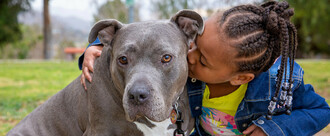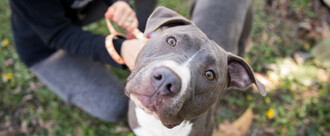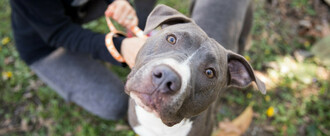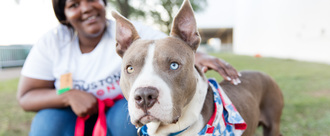-
Repeal The City Of Fayette BSL BanThis is an important issue because no animal should be ripped away from loving families and killed simply based on how it looks, what breed it is, or what characteristics it has.269 of 300 SignaturesCreated by Dana B.

-
End Breed Bans In Iowa!We cannot wait for someone else to do something about Breed Specific Language. Remaining silent will only allow your rights to be violated continuously. The time for action is not tomorrow-it is NOW! We stand together for all dogs, will you take a stand with us?268 of 300 SignaturesCreated by Kathleen C.
-
End ban on pit bulls in Ottumwa, IowaCities everywhere are deciding to revise these discriminatory bans to hold owners responsible no matter the breed or mix a dog is. This ban has not worked in keeping pitbull out of the city limits, it relies on out of town rescues and shelters to remove these types of dogs , stretching our neighbors resources is not being a responsible community.1,576 of 2,000 SignaturesCreated by Marcia M.
-
Poner fin a las prácticas de seguros que restringen la raza en IllinoisHay una gran variedad de perros que entran en la categoría de razas "de riesgo" según algunas compañías de seguros, como los bóxers, los schnauzers gigantes, los pastores alemanes, los chows, los gran daneses, los malamutes de Alaska, los staffordshire terrier americanos, los akitas, los corsos de Caña, los bulldogs americanos, los malinois belgas, los keeshonds, los ridgebacks de Rodesia, los ovtcharkas, los huskies siberianos, los dobermans, los pitbulls, los dálmatas, los rottweilers y los perros boyeros australianos, entre otros. La Asociación Nacional de Comisarios de Seguros [NAIC] debería proteger a los consumidores propietarios de mascotas. Las compañías de seguros deberían centrarse en el comportamiento del perro. Los perros con comportamiento agresivo no deberían estar protegidos por ninguna moratoria. Esto es importante porque los perros son vistos por la gran mayoría de los estadounidenses como parte de la familia, y la capacidad de las personas para mantener las familias unidas debe ser protegida. Las prácticas de seguro restrictivas en materia de razas pueden obligar a los propietarios responsables de mascotas a renunciar a ellas y aumentar el número de mascotas en los refugios. La probabilidad de que un perro muerda se basa en muchos factores, como la socialización del perro, el adiestramiento de obediencia, la supervisión proporcionada por el propietario y la forma en que la víctima interactúa con el perro. No se ha demostrado científicamente que el comportamiento agresivo esté presente en ninguna raza de perro en particular. Las compañías de seguros que quieran reducir el riesgo deben centrarse únicamente en el comportamiento del perro y en la conducta del propietario.120 of 200 SignaturesCreated by Caity K.
-
Poner fin a las prácticas de seguros que restringen la raza en ArizonaHay una gran variedad de perros que entran en la categoría de razas "de riesgo" según algunas compañías de seguros, como los bóxers, los schnauzers gigantes, los pastores alemanes, los chows, los gran daneses, los malamutes de Alaska, los staffordshire terrier americanos, los akitas, los corsos de Caña, los bulldogs americanos, los malinois belgas, los keeshonds, los ridgebacks de Rodesia, los ovtcharkas, los huskies siberianos, los dobermans, los pitbulls, los dálmatas, los rottweilers y los perros boyeros australianos, entre otros. La Asociación Nacional de Comisarios de Seguros [NAIC] debería proteger a los consumidores propietarios de mascotas. Las compañías de seguros deberían centrarse en el comportamiento del perro. Los perros con comportamiento agresivo no deberían estar protegidos por ninguna moratoria. Esto es importante porque los perros son vistos por la gran mayoría de los estadounidenses como parte de la familia, y la capacidad de las personas para mantener las familias unidas debe ser protegida. Las prácticas de seguro restrictivas en materia de razas pueden obligar a los propietarios responsables de mascotas a renunciar a ellas y aumentar el número de mascotas en los refugios. La probabilidad de que un perro muerda se basa en muchos factores, como la socialización del perro, el adiestramiento de obediencia, la supervisión proporcionada por el propietario y la forma en que la víctima interactúa con el perro. No se ha demostrado científicamente que el comportamiento agresivo esté presente en ninguna raza de perro en particular. Las compañías de seguros que quieran reducir el riesgo deben centrarse únicamente en el comportamiento del perro y en la conducta del propietario.101 of 200 SignaturesCreated by Caity K.
-
Poner fin a las prácticas de seguros que restringen la raza en FloridaHay una gran variedad de perros que entran en la categoría de razas "de riesgo" según algunas compañías de seguros, como los bóxers, los schnauzers gigantes, los pastores alemanes, los chows, los gran daneses, los malamutes de Alaska, los staffordshire terrier americanos, los akitas, los corsos de Caña, los bulldogs americanos, los malinois belgas, los keeshonds, los ridgebacks de Rodesia, los ovtcharkas, los huskies siberianos, los dobermans, los pitbulls, los dálmatas, los rottweilers y los perros boyeros australianos, entre otros. La Asociación Nacional de Comisarios de Seguros [NAIC] debería proteger a los consumidores propietarios de mascotas. Las compañías de seguros deberían centrarse en el comportamiento del perro. Los perros con comportamiento agresivo no deberían estar protegidos por ninguna moratoria. Esto es importante porque los perros son vistos por la gran mayoría de los estadounidenses como parte de la familia, y la capacidad de las personas para mantener las familias unidas debe ser protegida. Las prácticas de seguro restrictivas en materia de razas pueden obligar a los propietarios responsables de mascotas a renunciar a ellas y aumentar el número de mascotas en los refugios. La probabilidad de que un perro muerda se basa en muchos factores, como la socialización del perro, el adiestramiento de obediencia, la supervisión proporcionada por el propietario y la forma en que la víctima interactúa con el perro. No se ha demostrado científicamente que el comportamiento agresivo esté presente en ninguna raza de perro en particular. Las compañías de seguros que quieran reducir el riesgo deben centrarse únicamente en el comportamiento del perro y en la conducta del propietario.144 of 200 SignaturesCreated by Caity K.
-
Poner fin a las prácticas de seguros que restringen la raza en TexasHay una gran variedad de perros que entran en la categoría de razas "de riesgo" según algunas compañías de seguros, como los bóxers, los schnauzers gigantes, los pastores alemanes, los chows, los gran daneses, los malamutes de Alaska, los staffordshire terrier americanos, los akitas, los corsos de Caña, los bulldogs americanos, los malinois belgas, los keeshonds, los ridgebacks de Rodesia, los ovtcharkas, los huskies siberianos, los dobermans, los pitbulls, los dálmatas, los rottweilers y los perros boyeros australianos, entre otros. La Asociación Nacional de Comisarios de Seguros [NAIC] debería proteger a los consumidores propietarios de mascotas. Las compañías de seguros deberían centrarse en el comportamiento del perro. Los perros con comportamiento agresivo no deberían estar protegidos por ninguna moratoria. Esto es importante porque los perros son vistos por la gran mayoría de los estadounidenses como parte de la familia, y la capacidad de las personas para mantener las familias unidas debe ser protegida. Las prácticas de seguro restrictivas en materia de razas pueden obligar a los propietarios responsables de mascotas a renunciar a ellas y aumentar el número de mascotas en los refugios. La probabilidad de que un perro muerda se basa en muchos factores, como la socialización del perro, el adiestramiento de obediencia, la supervisión proporcionada por el propietario y la forma en que la víctima interactúa con el perro. No se ha demostrado científicamente que el comportamiento agresivo esté presente en ninguna raza de perro en particular. Las compañías de seguros que quieran reducir el riesgo deben centrarse únicamente en el comportamiento del perro y en la conducta del propietario.112 of 200 SignaturesCreated by Caity K.
-
Poner fin a las prácticas de seguros que restringen la raza en CaliforniaHay una gran variedad de perros que entran en la categoría de razas "de riesgo" según algunas compañías de seguros, como los bóxers, los schnauzers gigantes, los pastores alemanes, los chows, los gran daneses, los malamutes de Alaska, los staffordshire terrier americanos, los akitas, los corsos de Caña, los bulldogs americanos, los malinois belgas, los keeshonds, los ridgebacks de Rodesia, los ovtcharkas, los huskies siberianos, los dobermans, los pitbulls, los dálmatas, los rottweilers y los perros boyeros australianos, entre otros. La Asociación Nacional de Comisarios de Seguros [NAIC] debería proteger a los consumidores propietarios de mascotas. Las compañías de seguros deberían centrarse en el comportamiento del perro. Los perros con comportamiento agresivo no deberían estar protegidos por ninguna moratoria. Esto es importante porque los perros son vistos por la gran mayoría de los estadounidenses como parte de la familia, y la capacidad de las personas para mantener las familias unidas debe ser protegida. Las prácticas de seguro restrictivas en materia de razas pueden obligar a los propietarios responsables de mascotas a renunciar a ellas y aumentar el número de mascotas en los refugios. La probabilidad de que un perro muerda se basa en muchos factores, como la socialización del perro, el adiestramiento de obediencia, la supervisión proporcionada por el propietario y la forma en que la víctima interactúa con el perro. No se ha demostrado científicamente que el comportamiento agresivo esté presente en ninguna raza de perro en particular. Las compañías de seguros que quieran reducir el riesgo deben centrarse únicamente en el comportamiento del perro y en la conducta del propietario.136 of 200 SignaturesCreated by Caity K.
-
End Breed-Restrictive Insurance Practices in CaliforniaThere is a wide range of dogs falling within the category of “risk” breeds according to some insurance companies including Boxers, Giant Schnauzers, German Shepherds, Chows, Great Danes, Alaskan Malamutes, American Staffordshire Terriers, Akitas, Cane Corsos, American Bulldogs, Belgian Malinois, Keeshonds, Rhodesian Ridgebacks, Ovtcharkas, Siberian Huskies, Dobermans, Pit Bulls, Dalmatians, Rottweilers, Australian Cattle dogs and more. The National Association of Insurance Commissioners [NAIC] should protect pet-owning consumers. Insurance companies should focus on the behavior of the dog. Dogs with aggressive behavior should not be protected by any moratorium. This is important because dogs are viewed by the vast majority of Americans as part of the family, and the ability for people to keep families together should be protected. Breed-restrictive insurance practices can force responsible pet owners to give up their pets and increase the number of pets in shelters. The likelihood a dog will bite is based on many factors such as socialization of the dog, obedience training, supervision provided by the owner, and how the victim interacts with the dog. It has not been proven by scientific evidence that aggressive behavior is present in any particular breed of dog. Insurance companies that want to reduce risk should focus solely on behavior of the dog and the behavior of the owner.2,778 of 3,000 SignaturesCreated by Caity K.
-
End Breed-Restrictive Insurance Practices in FloridaThere is a wide range of dogs falling within the category of “risk” breeds according to some insurance companies including Boxers, Giant Schnauzers, German Shepherds, Chows, Great Danes, Alaskan Malamutes, American Staffordshire Terriers, Akitas, Cane Corsos, American Bulldogs, Belgian Malinois, Keeshonds, Rhodesian Ridgebacks, Ovtcharkas, Siberian Huskies, Dobermans, Pit Bulls, Dalmatians, Rottweilers, Australian Cattle dogs and more. The National Association of Insurance Commissioners [NAIC] should protect pet-owning consumers. Insurance companies should focus on the behavior of the dog. Dogs with aggressive behavior should not be protected by any moratorium. This is important because dogs are viewed by the vast majority of Americans as part of the family, and the ability for people to keep families together should be protected. Breed-restrictive insurance practices can force responsible pet owners to give up their pets and increase the number of pets in shelters. The likelihood a dog will bite is based on many factors such as socialization of the dog, obedience training, supervision provided by the owner, and how the victim interacts with the dog. It has not been proven by scientific evidence that aggressive behavior is present in any particular breed of dog. Insurance companies that want to reduce risk should focus solely on behavior of the dog and the behavior of the owner.2,193 of 3,000 Signatures
-
End Breed-Restrictive Insurance Practices in MontanaThere is a wide range of dogs falling within the category of “risk” breeds according to some insurance companies including Boxers, Giant Schnauzers, German Shepherds, Chows, Great Danes, Alaskan Malamutes, American Staffordshire Terriers, Akitas, Cane Corsos, American Bulldogs, Belgian Malinois, Keeshonds, Rhodesian Ridgebacks, Ovtcharkas, Siberian Huskies, Dobermans, Pit Bulls, Dalmatians, Rottweilers, Australian Cattle dogs and more. The National Association of Insurance Commissioners [NAIC] should protect pet-owning consumers. Insurance companies should focus on the behavior of the dog. Dogs with aggressive behavior should not be protected by any moratorium. This is important because dogs are viewed by the vast majority of Americans as part of the family, and the ability for people to keep families together should be protected. Breed-restrictive insurance practices can force responsible pet owners to give up their pets and increase the number of pets in shelters. The likelihood a dog will bite is based on many factors such as socialization of the dog, obedience training, supervision provided by the owner, and how the victim interacts with the dog. It has not been proven by scientific evidence that aggressive behavior is present in any particular breed of dog. Insurance companies that want to reduce risk should focus solely on behavior of the dog and the behavior of the owner.156 of 200 Signatures
-
End Breed-Restrictive Insurance Practices in IndianaThere is a wide range of dogs falling within the category of “risk” breeds according to some insurance companies including Boxers, Giant Schnauzers, German Shepherds, Chows, Great Danes, Alaskan Malamutes, American Staffordshire Terriers, Akitas, Cane Corsos, American Bulldogs, Belgian Malinois, Keeshonds, Rhodesian Ridgebacks, Ovtcharkas, Siberian Huskies, Dobermans, Pit Bulls, Dalmatians, Rottweilers, Australian Cattle dogs and more. The National Association of Insurance Commissioners [NAIC] should protect pet-owning consumers. Insurance companies should focus on the behavior of the dog. Dogs with aggressive behavior should not be protected by any moratorium. This is important because dogs are viewed by the vast majority of Americans as part of the family, and the ability for people to keep families together should be protected. Breed-restrictive insurance practices can force responsible pet owners to give up their pets and increase the number of pets in shelters. The likelihood a dog will bite is based on many factors such as socialization of the dog, obedience training, supervision provided by the owner, and how the victim interacts with the dog. It has not been proven by scientific evidence that aggressive behavior is present in any particular breed of dog. Insurance companies that want to reduce risk should focus solely on behavior of the dog and the behavior of the owner.437 of 500 Signatures












